Canon EOS R8 Review
Dustin Abbott
April 15th, 2024

About a year ago I reviewed what in many ways is the progenitor of this camera – the Canon EOS R6 MK II. The Canon EOS R8 inherits the sensor and autofocus system of that model, though the Canon EOS R8 is in many ways the second generation of the Canon EOS RP, Canon’s first entry level full frame mirrorless camera. The RP had its strengths, though it was also severely compromised in many ways. There are certainly places where I can see the cost cutting here, too, but despite those intentional places where features are chiseled away to allow for both market separation and cost cutting to allow Canon to sell this camera for $1500 USD ($1300 at the moment of this review due to a discount), the EOS R8 has a clear advantage that the RP did not. The EOS RP came very early in Canon’s mirrorless development, and, as a byproduct, it borrowed Canon’s DSLR technology. It’s sensor was the rather disappointing one from the Canon EOS 6D MK II, whereas the EOS R8 has inherited the vastly superior sensor and autofocus system of the Canon EOS R6 MK II. The R6MK II was the “poor man’s” EOS R3, which I guess makes the EOS R8 the poor man’s EOS R6 MK II.
But the EOS R8 benefits from inheriting from a very good camera, and the end result is a camera I had a lot of fun using despite its limitations. You can find my full thoughts by watching my video review here…or reading on.
__________________________________________________________________________________________________
Follow Me @ YouTube | Patreon | Instagram | Facebook | DA Merchandise | Flickr | 500px | X
Thanks to Camera Canada for sending me a review loaner of this camera. They have become my go-to retailer for my own purchases here in Canada. As always, this is a completely independent review, and the thoughts and opinions expressed here are my own.
__________________________________________________________________________________________________
A quick summary of strengths and weaknesses before we dive into the details. Strengths include an excellent sensor, excellent autofocus, a nicely executed compact body that retains good ergonomics, a vari-angle touchscreen with good responsiveness, and fairly good video specs including 4K60. This is a compact, lightweight camera that doesn’t skimp on performance or usability. Major weaknesses include a lack of IBIS (In-Body-Image-Stabilization), a smaller battery, no navigational joystick, a single SD card (and correspondingly shallow buffers), and a shutter speed limit of 1/4000th second.

Unfortunately the EOS R8 suffers from a blight shared by all Canon RF cameras: the Canon RF mount remains closed to third party autofocusing lens development. I still own two very early Samyang RF mount lenses (14mm F2.8 and 85mm F1.4) that fortunately still work fine on the EOS R8 but were quickly shut down by Canon. Samyang no longer sells them, and there have been no new lenses from Samyang, Sigma, Tamron, or Viltrox. It’s very unfortunate, as there are now hundreds of lenses for Sony E-mount available from a wide variety of lens makers that aren’t available to Canon RF. It is a significant disadvantage, as while there are some excellent RF mount lenses, there are far fewer choices available. I continue to love using the Samyang RF 85mm F1.4 on my own EOS R5 (and on this EOS R8), and it is pretty irritating that this reasonably priced fantastic portrait lens existed but doesn’t now other than the rare second hand copy out there.
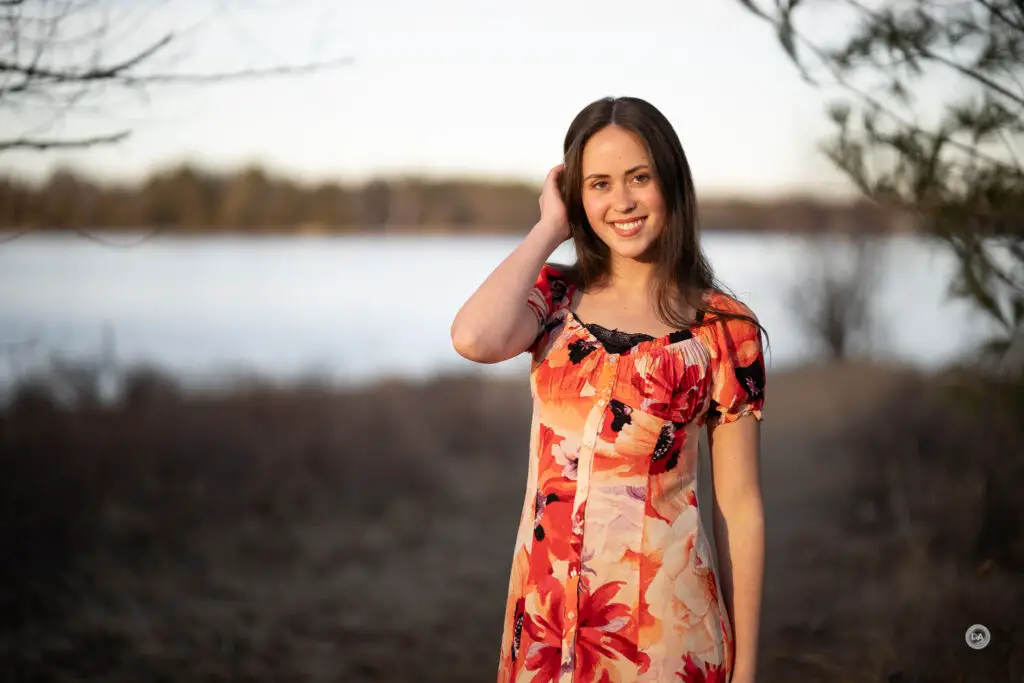
That rant aside, I had a lot of fun with the EOS R8. Here’s why…
Spec List
- 24.2MP Full-Frame CMOS Sensor
- 4K60p 10-Bit Internal Video, Canon Log 3
- 2.36m-Dot OLED Electronic Viewfinder
- 3.0″ 1.62m-Dot Vari-Angle Touchscreen
- Dual Pixel CMOS AF II
- 40 fps Electronic Shutter
- Movie Digital IS
- Vertical Movie Mode
- Microphone Input, Headphone Output
- Multi-Function Shoe, Wi-Fi & Bluetooth
Build and Features
Canon is one of the absolute best in the business at making ergonomically pleasing cameras. I was incredibly impressed at how the EOS R8 manages to be both extremely compact and lightweight while also being very comfortable to hold and use. I typically prefer a larger camera, as my hands are a bit bigger, but the EOS R8 felt better in my grip than my high end Sony cameras (a7RV and Alpha 1). I had my wife hold the camera, and she loved the way it felt in her smaller hands. Part of that is that Canon does a much better job of creating space between the grip and the lens mount, whereas Sony has stubbornly refused to widen their cameras and that problem remains. The EOS R8 is 5.22 [W] x 3.39 [H] x 2.76″ [D] (132.59 x 86.11 x 70.1 mm) and weighs only one pound (461g) even with the battery and memory card installed.
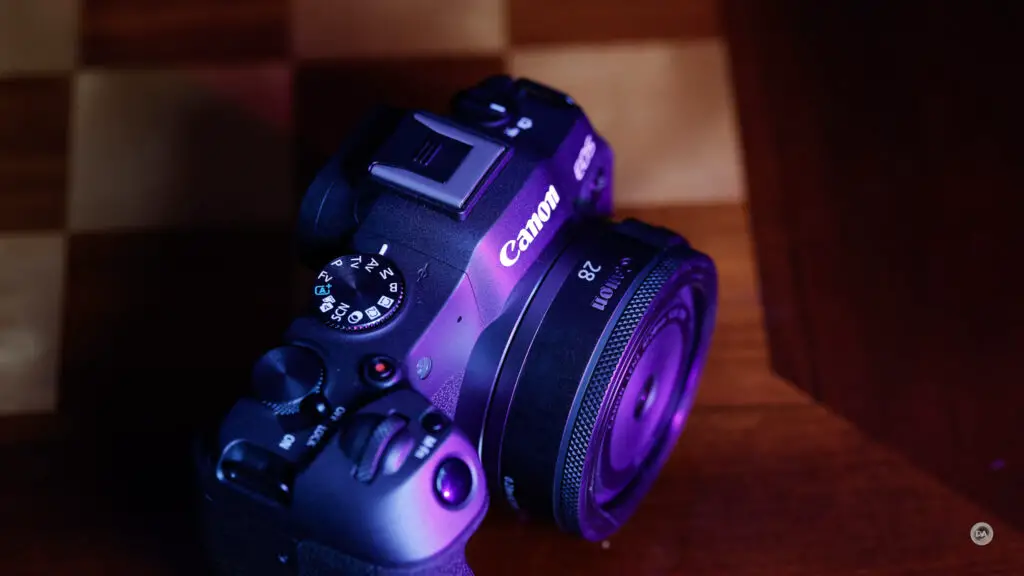
The EOS R8 feels excellent in the hand, and the grip is substantial enough that it doesn’t feel like any of my fingers have no place to rest.
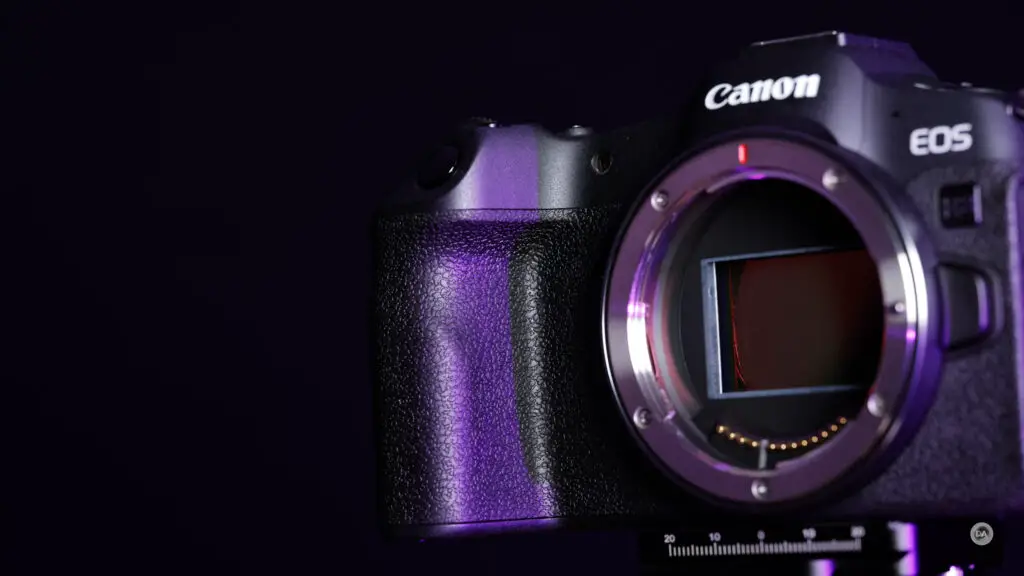
The primary controls come via two wheels and a D-pad. The first control wheel is located right behind the shutter button with the second at the back of the top plate that is connected to the On/LOCK/Off lever. Rather than traditional third around the SET button on the back of the camera we have the directional pad that Canon puts on its less expensive cameras instead. The movement of the two wheels feels good (familiar and substantial), but I also miss having that third wheel. Also missed here is a navigational joystick. You’ll have to make due with either the D-pad or by using the touchscreen to navigate.
On the left side of the viewfinder is the Stills/Video switch. I like having this type of control as it does allow you to have a completely different setup for your video controls, including a separate customization set for buttons and wheels. I devoted some digital ink in my R6 II review complaining about how this switch is the exact same spot as the ON/OFF switch on my EOS R5, so I ended up switching between stills and video rather than turning the camera on and off many times. That’s still true, but at least Canon is showing some consistency. The ON/OFF button is also on the right side on the EOS R50 I’m reviewing as well, so this seems to be their new position.

On the right side of the top plate there is a mode dial along with the record button and an M-Fn button that can be customized to a variety of functions. Canon’s higher end cameras have a secondary LCD on top, but I actually find that the old-fashioned mode dial is still the fastest way to get to different functions. There are a wide variety of options on the mode dial, including two different custom configurations.
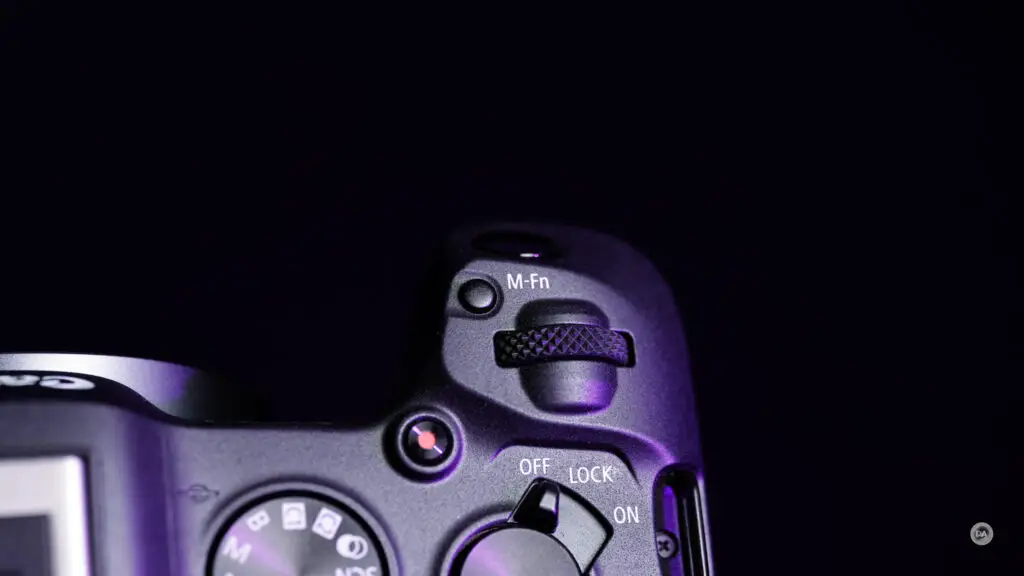
The front of the camera just has the lens release. There are no custom buttons there. Unlike their more expensive models, there is no option to have the shutter blades come down when the camera is powered off to protect the sensor from dust. What is there is a very aggressive sensor cleaning cycle that doesn’t just come on when you power the camera off but also whenever a lens is released or attached. This is a new one for me, and at first it didn’t register what the clicking noise was whenever I attached/released a lens.

There is a Canon-standard set of buttons present on the back of the camera, most all of which can be customized to different functions. Everything is pretty much in the place I’ve come to expect on a Canon camera, with the menu button to the left of the viewfinder, a cluster of three buttons near the grip, and another above and under the directional pad. There are no dedicated custom buttons, however, so you’ll have to reassign a value to an existing button if you want to add a quick access function. The back of the camera looks very similar to the EOS RP.
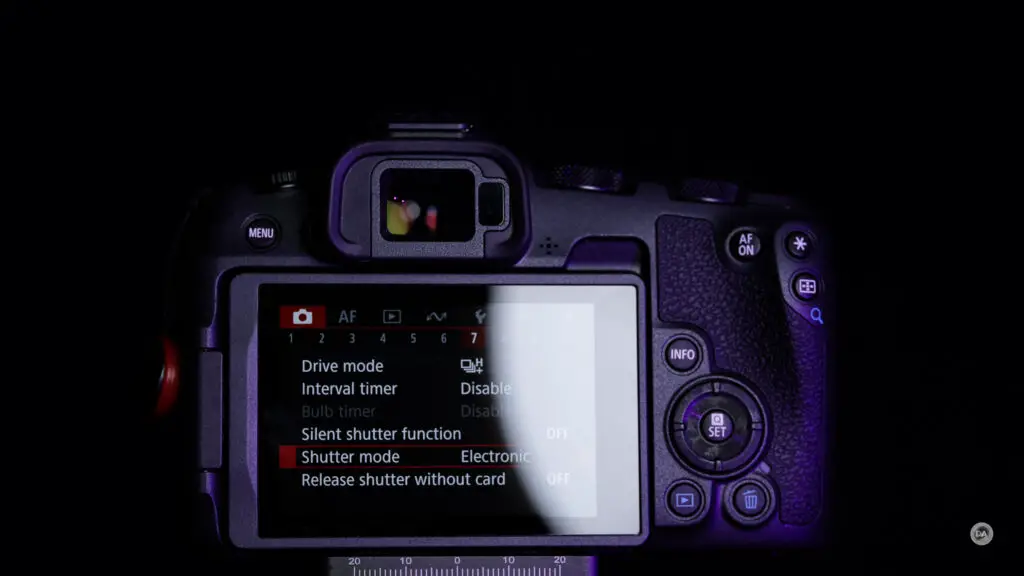
You’ll also find a 3” articulating LCD touchscreen with a 1.62 million dot resolution. This is nothing special, these days, but Canon’s LCD screens remain the best in terms of touch performance, with very quick reaction times and good sensitivity. Canon’s menu design is the friendliest of the brands I test to navigate by touch.
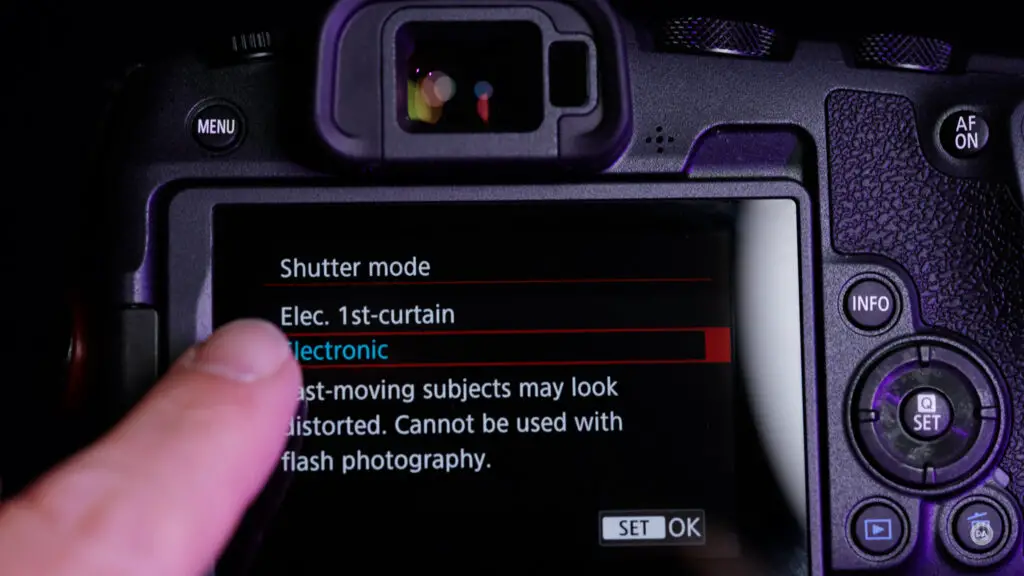
The viewfinder is an OLED electronic viewfinder with a 2.36 million dot resolution. It’s only 0.39″ in size, so not overly engaging, and has a magnification level of 0.70x. Pretty unimpressive, really, though on par with something like Sony’s a7C series.
The left size port organization is highly similar to many of Canon’s cameras and unfortunately continues the trend of having flaps (hard to keep out of the way) instead of doors that can be smoothly opened (and left open when desired). There is a USB Type-C port for communication along with a micro-HDMI video out. That latter is a Canon standard and is rarely anyone’s favorite for the simple reason that micro-HDMI is more flimsy than larger HDMI ports. The EOS R8 has some decent video specs, but no serious videographer wants to deal with a micro-HDMI. You can charge the camera via the USB-C port, though you’ll need a power bank with the appropriate power delivery (PD) standard. Another flap covers a 3.5mm microphone jack along with a similar headphone monitoring jack, while the final smaller flaps covers a remote release cable port. The hot-shoe on top allows you to connect certain microphones and get digital audio through it.
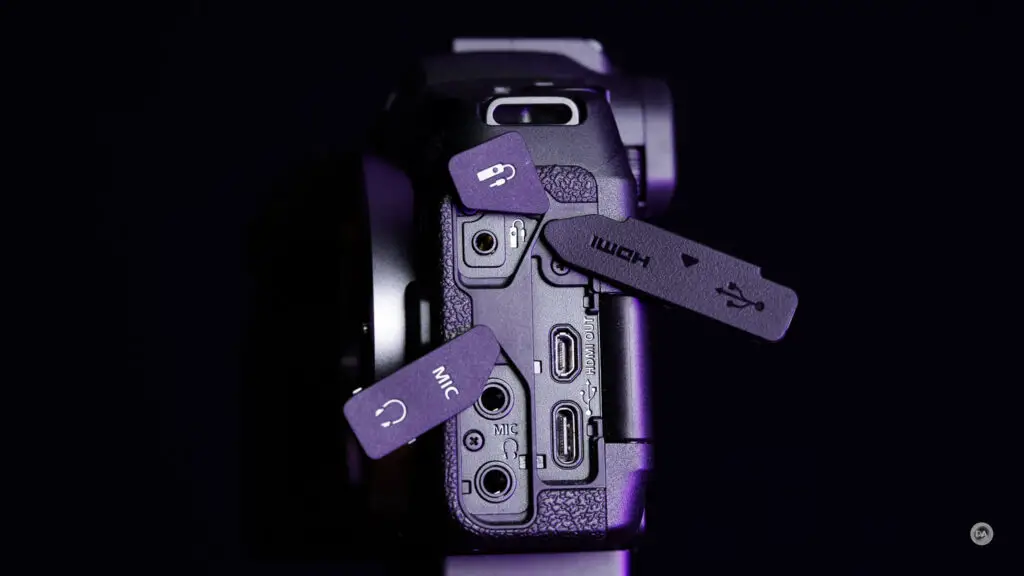
There is nothing on the right side of the camera, as the lone memory card slot is unfortunately in the undesirable position of being down in the battery compartment. We have a single SD/SDHC/SDXC slot that is UHS-II compatible for increased speed. This isn’t surprising, per se, but certainly not welcome, either. I hate this position, myself, as it leaves you with two unpalatable choices with the memory card out. One is put the camera on it’s side to leave the battery door open. The other is to close it so that you can put the camera down normally, but then you run the risk of forgetting that the memory card is not inserted back in the camera, which can be disastrous if you are arrive on site to shoot only to realize there is no card in the camera.

The EOS R8 is saddled with the smaller LP-E17 battery pack rather than the more common Canon LP-E6NH used in most of the other full frame Canon cameras. This smaller battery has a capacity of just 1040mAh, which is less than 50% of the rating of the LP-E6NH. The rating is just 150 shots, though it isn’t hard to exceed that. The bigger issue will be long format video recording, as that burns through batteries pretty quickly. The camera is capable of recording up to 120 minutes of 4K, according to Canon, but don’t expect the battery to last that long. I would definite buying a spare or two…
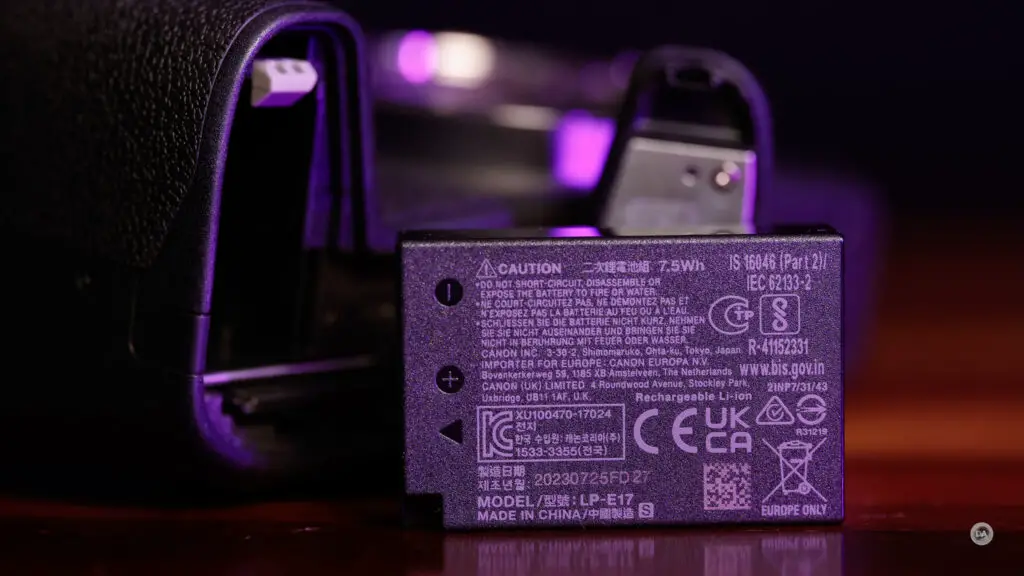
The shutter is interesting, as there isn’t a fully mechanical shutter option, but rather an electronic first curtain mechanical option along with a fully electronic shutter option. The former has a shutter speed limit of 1/4000th second (and also a pretty pedestrian 6FPS burst rate) while the latter gives an upper limit of 1/8000th of a second and unlocks a MUCH faster burst rate of up to 40FPS, though that will be constrained by the shallow buffer depth available here. The electronic shutter will just make a very quiet electronic click without a typical shutter sound. The EOS R8 will not have the ultrafast readout of a camera designed purely around an electronic shutter (like the EOS R3, for example), so there are some penalties for using the electronic shutter here. You can’t use it with a flash (no sync is available), can’t engage anti-flicker mode, and sometimes fast moving action might be distorted a bit (rolling shutter). Canon also uses 12bit A/D conversion with the electronic shutter rather than 14bit with the EFC shutter, but you probably won’t notice the difference.
Bottom line – the EFC option is more flexible and produces slightly better image quality, but it is much slower and has maximum shutter speed of 1/4000th. The electronic option unlocks much faster burst rates and a higher shutter speed limit, but has other limitations. Choose appropriately to your situation.

The EOS R8 does have some decent communication options including wireless LAN and Bluetooth 4.2. Interestingly, you can plug it directly into a phone with a MiFI-certified cable (USB-C port).
Canon uses a few more plastics in this body than their more premium models, but everything feels very good here. The camera feels tough and durable, and I’ve used a lot of Canon cameras for the long haul and they’ve held up fine. There is some measure of weather sealing in the camera body, though Canon reports that the sealing is less than what is found on the EOS R6/R6II.
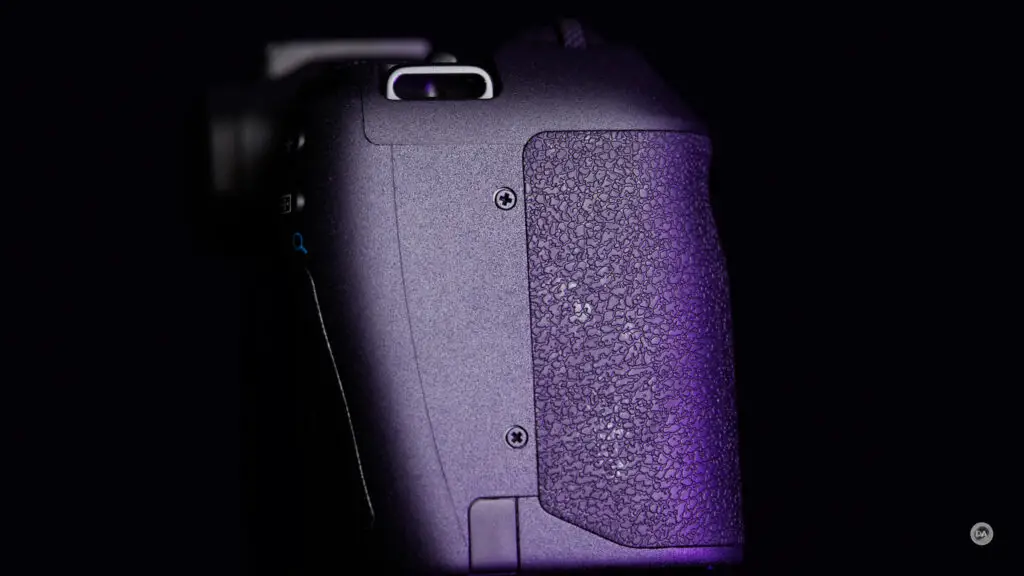
Perhaps the biggest missing feature in the EOS R8 is the lack of IBIS (in body image stabilization). That has become increasingly rare, and competing models like the Sony a7C/II or the Nikon Z5 are equipped with IBIS. Early in the mirrorless cycle Canon was adamant that lens based stabilization was superior (neither the EOS R or RP had IBIS), but market pressure eventually pushed them into including this incredibly useful feature in the next generation of camera bodies. It is an unfortunate omission, as I personally will not buy a camera without IBIS at this stage. While there are a number of Canon lenses that do have lens based stabilization, about a third of them do not, and that number includes a number of the small, light primes that suit this camera so well (RF 16mm F2.8, 28mm F2.8, and 50mm F1.8).
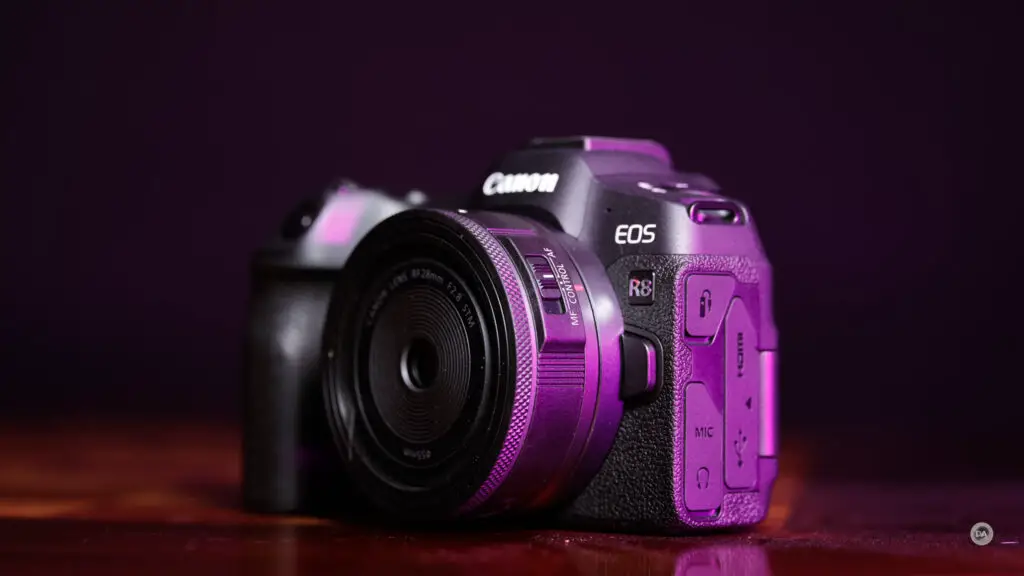
There is a “Digital IS” available (for movie mode only), though this is a digital correction and will come at the cost of a crop of your video and won’t be as effective as an actual optical stabilizer.
The “kit lens” for the Canon EOS R8 is the Canon RF 24-50mm F4.5-6.3 IS STM, and while it is nothing special, it is inexpensive (an additional $200 in kit) and does give you an image stabilizer.

Every company makes a series of choices about what compromises to make in their lower-priced options. They have to include enough to keep the cameras competitive and marketable, but not so much as to rob sales from more premium cameras. There will always be areas where you or I will disagree with some of those decisions, and that’s true here. What’s also true is that the EOS R8 is a very usable camera that handles well overall.
Autofocus Performance
There were areas where Canon has cut features from the EOS R8, but autofocus is not one of them. The EOS R8 utilizes Canon’s Dual Pixel CMOS AF II focus system just like the EOS R6 MK II, which inherited a similar system from the high end EOS R3. This is a robust focus system that covers approximately 100% x 100% of the picture area, with up to 1,053 automatically-selected AF zones utilized during Whole Area AF. Bottom line is that you can compose your shot basically anywhere with impunity, and the camera will also track all across the frame, making it easy to stop action.

Canon offers an “auto” mode for subject tracking that I really appreciate, as I have sometimes gotten less than excellent results on Sony or Fuji if I don’t have the right subject selected. I also really enjoy how engaging Canon’s tracking is. It is very clear on the screen what is being tracked.
Eye AF worked very well whether it was animal, bird, or human subjects. The wide range of focus points means that you really don’t have to worry about where in the frame the subject is. It wasn’t that long ago that I was using a Canon EOS 6D pretty much exclusively with the center focus point – focus and recompose. The fact that a budget camera has an autofocus system that even a 1D level camera would have loved to have is a testament to how much better autofocus is on mirrorless. This camera was a delight to use in a portrait session, nailing focus every time.

Focus sensitivity is excellent, as the focus system can focus down to a -6.5 EV (which is VERY dark), though that figure will vary depending on the maximum aperture available on the lens mounted. A lens with a very bright aperture (like the F1.2 lenses) gives the autofocus system the potential of much more light to work with than a lens with a dimmer aperture. I found that I could still quickly lock onto a subject even in a nearly dark room. This shot was taken at ISO 51,200.
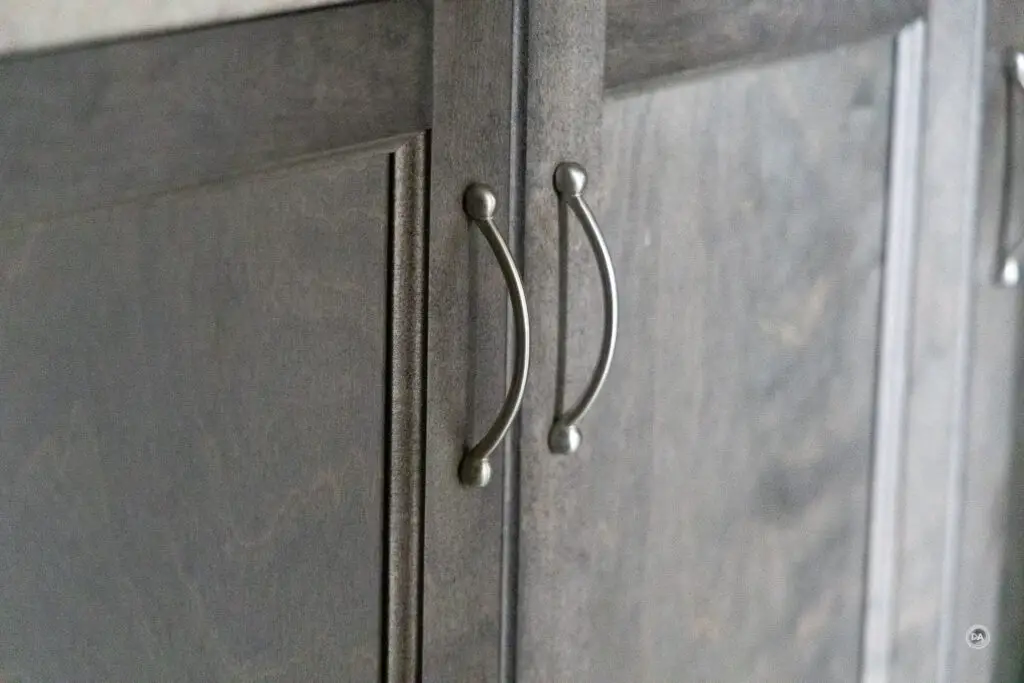
I also noted when doing some video work that Canon’s intelligent tracking works very well. If you click on a subject and select it you can easily move around the scene while keeping focus on the desired location.
For tracking purposes this is the same AF system as the R6 MK II, which is largely the same focus system as in the top tier EOS R3 sports camera. Tracking works very well, and you have the option of firing off a ridiculous amount of frames with the electronic shutter. I took about 100 photos in less than 3 seconds during a burst of Nala dashing towards me through the rain. At 40FPS you can afford to be very selective about what moment of action you choose. Here’s a few examples.
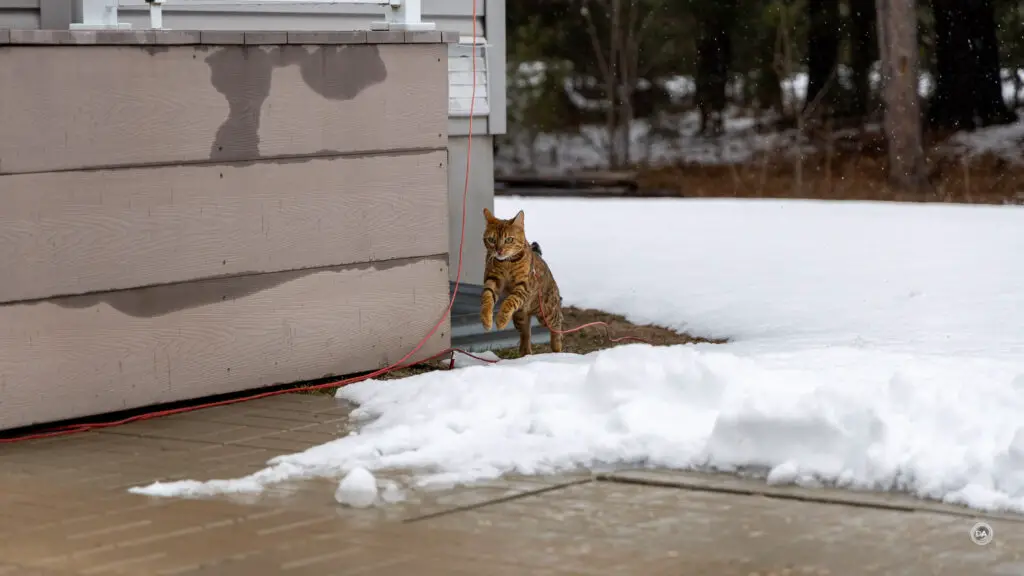
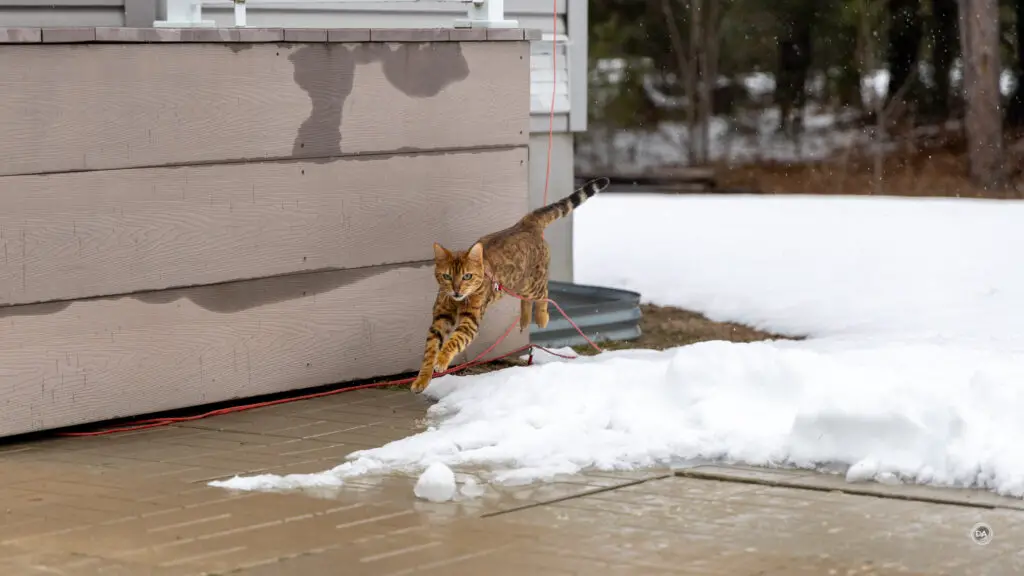

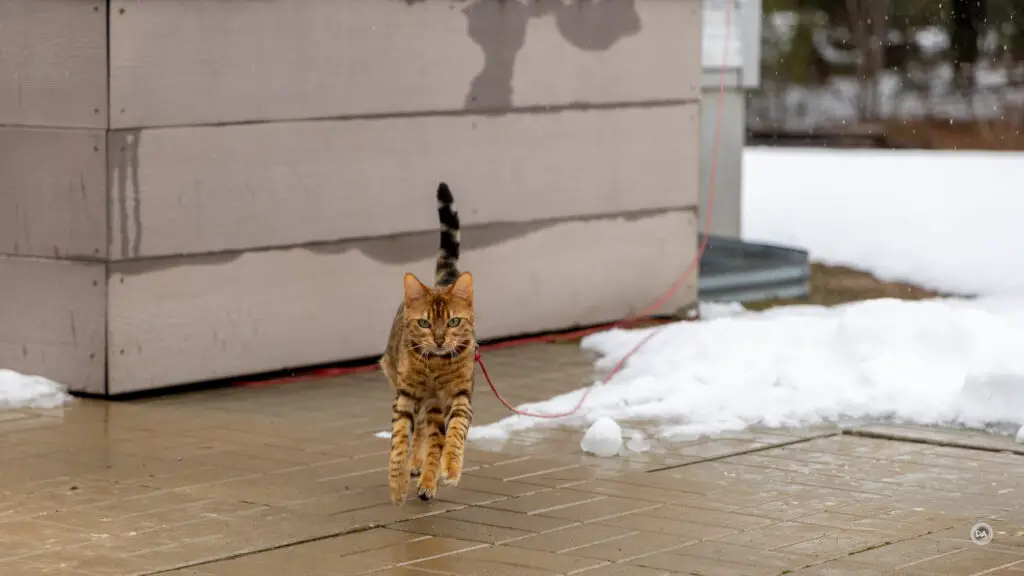
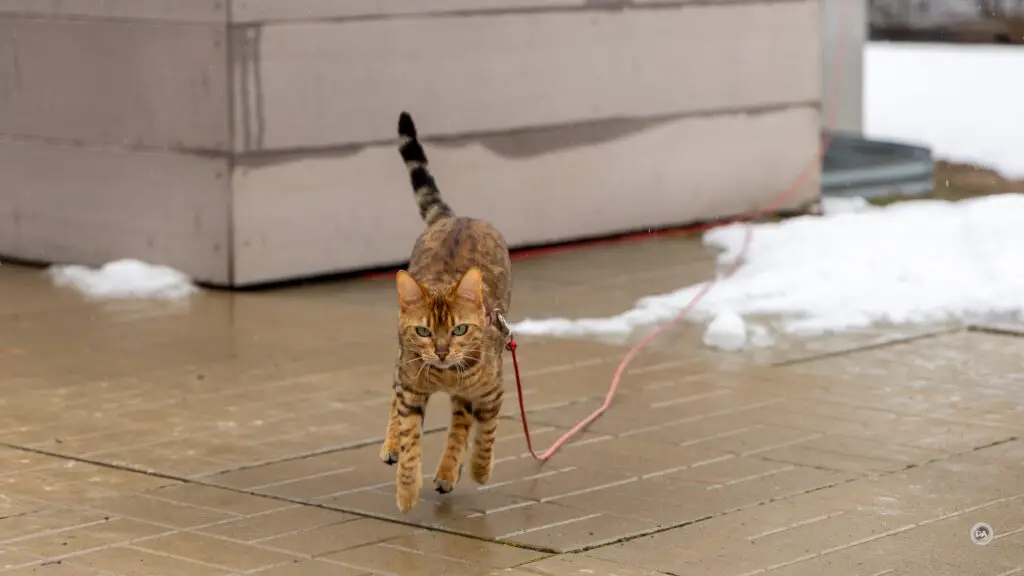
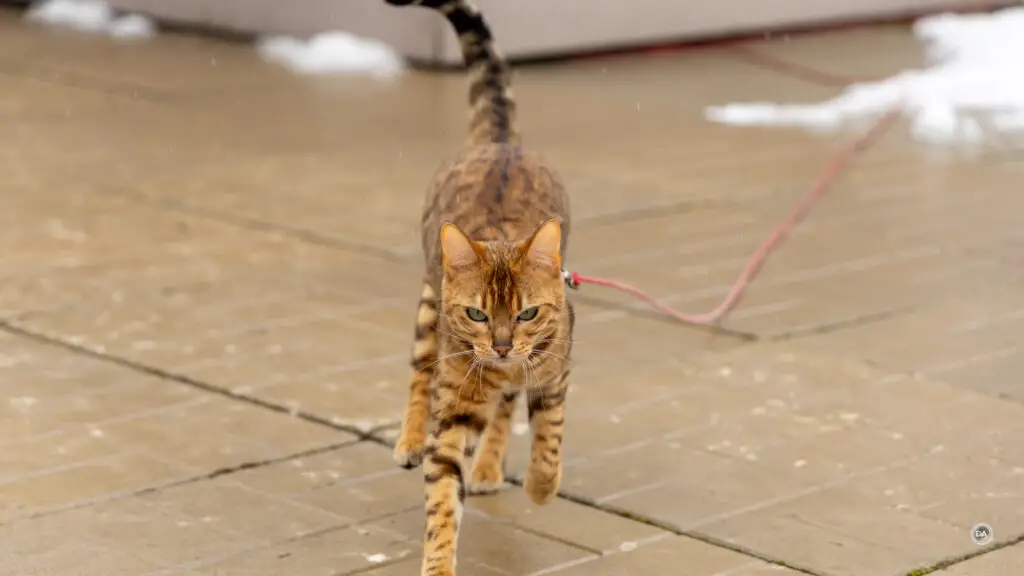
What’s amazing is that every shot at 40FPS is perfectly in focus despite the rapid movement (this burst shot with the Canon RF 24-105mm F4L IS). I’ve found that there are camera/lens combination that can’t keep up with a cat walking towards the camera much less running full tilt. This is a very impressively focusing camera.
As is typical with lesser cameras that inherit the focus systems of more sports oriented cameras, the weak link is the buffer depth. If you use the Electronic First Curtain shutter and its slow 6FPS burst rate, you’ll have no problems. Throw a fast card in there and you can capture 1000+ RAW images. But with the faster 40FPS burst rate of the Electronic shutter, the amount of information that must be processed is vastly different. A high speed card (UHS-II) is rated for up to 56 uncompressed RAW images, but if you shoot in CRAW (and you definitely should in those situations!) the buffer depth climbs to 100 images, which is enough to be useful. I got that many in the burst above (actually CRAW + JPEG) without any hint of slowdown, though I was using a very good Sony Tough UHS-II SD card (my cards of choice).
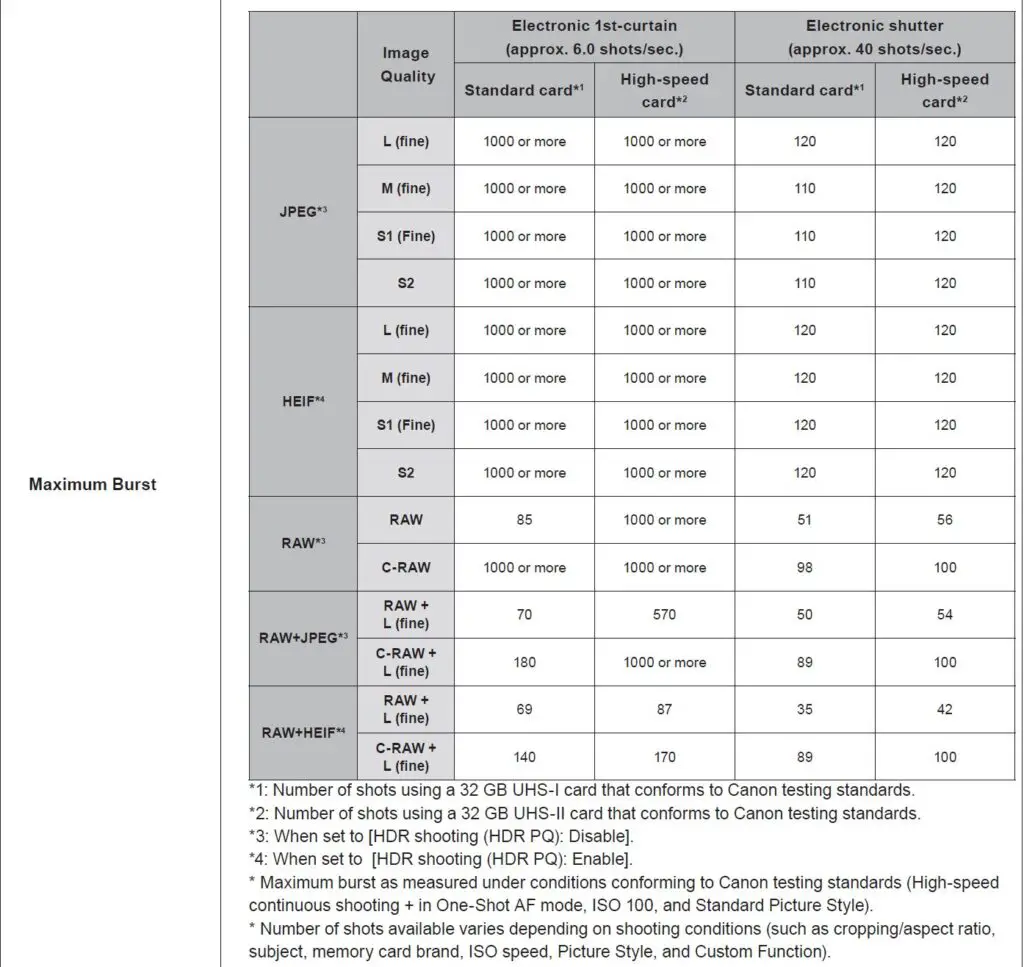
Throttle back to a still very fast 20FPS in electronic mode, and I think you could capture most of the action that you need even if you need to hold the shutter longer than a few seconds. I find this performance fairly impressive for this level of camera. And, for a little perspective, the Canon EOS 5D MKIV (a camera that cost more than 2.5x as much) had a maximum buffer depth of 17 RAW images and a maximum burst rate of 7FPs…and that was considered pretty good for the time. We’ve come a LONG way!
The EOS R8 also has another trick up its sleeve to help you get that crucial shot. There is a new option called RAW Burst Mode, and it functions by starting shooting slightly before (about 0.5 seconds earlier) the shutter button is fully pressed at a 30FPS burst rate to make sure you don’t miss the shot.

All told, this is an amazingly good focus system that is a real joy to use. Getting well focused results in just about any setting is pretty much effortless. To get an AF system this good in a budget camera is, well, impressive.
Video Performance
The Canon EOS RP was a fun camera for stills in many ways, but I found it utterly frustrating for video work. The autofocus for video reverted to a very primitive contrast AF system (it was terrible!) and 4K was only achievable at a very big 1.7x crop factor. Fortunately the EOS R8 is a completely different kettle of fish, utilizing the same fantastic AF system for video and offering very useful video specs.
The highlight spec here is that the EOS R8 can record 4K60 video with 6K oversampling. There is no crop factor, either – that is full sensor width. That 60FPS produces highly detailed footage that is further benefitted from the great autofocus in the camera. Here’s a look at the various video formats available on the EOS R8 (from Canon’s “white paper” on the camera).

You do have the option for shooting with an APS-C crop at 60FPS as well, which could be useful if you have some APS-C lenses kicking around or want to tighten your framing (Canon’s APS-C crop is 1.6x).
We have thankfully passed the era where video recordings were artificially limited at the 29:59 minute mark, so recording will (in theory) continue until the memory card is filled, as shown by this chart.
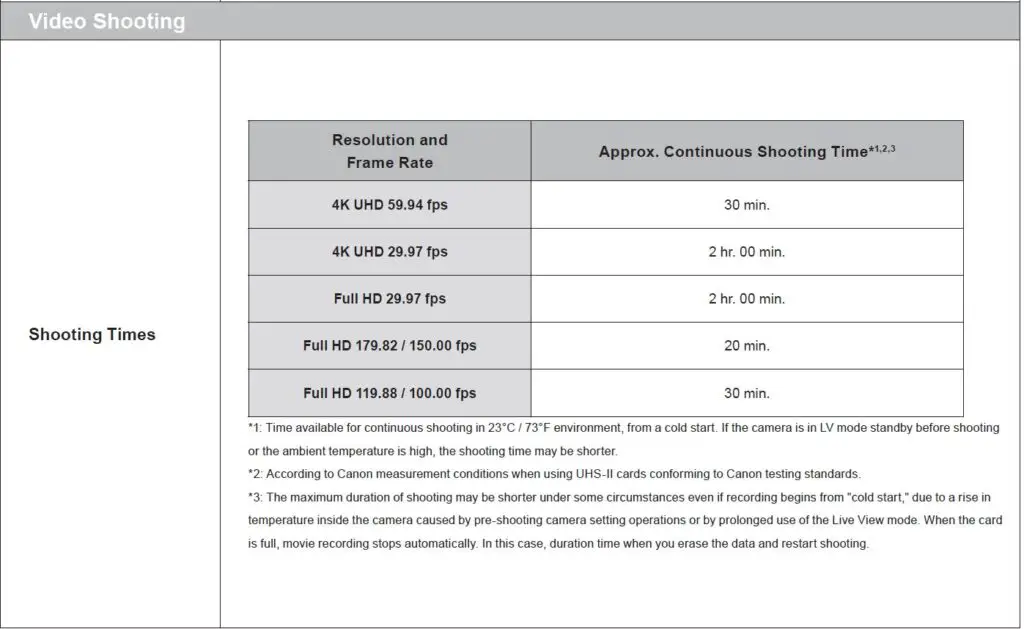
At higher bitrates where more heat is generated, you might see an earlier shutdown due to heat (if you have a large memory card). The shortest estimated recording time is 30 minutes at 4K60, but that jumps to 2 hours if you shoot 4K30 instead, so that shouldn’t be a major issue for many people. There is a Heat Control submenu that gives you options on how you want the camera to handle heat related issues.
As noted, 4K recording is limited to 60FPS, but up to 180FPS is available at Full HD (1080P) for serious slow-motion work. We would all love to have 4K120, of course, but these video specs are well in line with the competition in the market. The EOS R8 also includes Canon Log 3 (enables a consistent standard for grading) and HDR PQ for higher dynamic range footage. Here’s a single frame from a 4K60 recording in the middle of that spring snowstorm…and you can see lovely detail everywhere along with nice dynamic range (a bit further I’ll show a RAW photo I took during the same sequence).
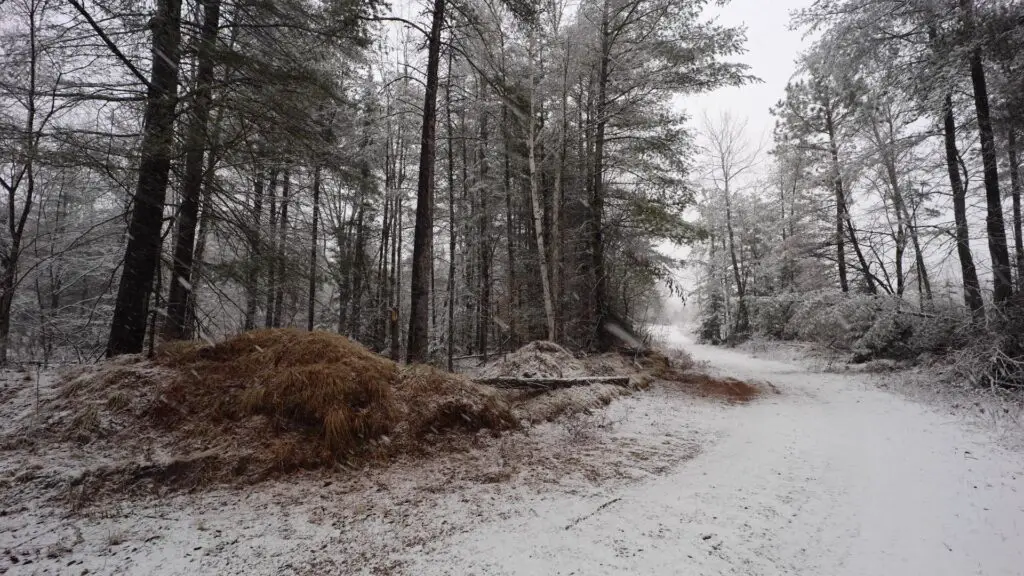
The only real feature missing here relative to the EOS R6 MK II is that model’s ability to output 6K ProRes footage via HDMI. The EOS R8 does have UVC/UAC compatibility which allows the camera to be used as a web camera to stream live video in Full HD without additional software. You have an option to shoot in vertical mode as well if so desired.
The vari-angle LCD is great for video, allowing you to shoot at waist height for more stability, down low on a gimbal, or front monitoring if you are in front of the camera.
As noted previously, the EOS R8 has the option to set up completely different menu and button options for video that can be accessed by switching the lever to the left of the viewfinder.
Sensor Performance
The Canon EOS R8 utilizes the same sensor found in the R6 MK II, and while on paper it might look like a regression from the sensor found in the EOS RP, this couldn’t be further from the proof. While on paper the RP’s sensor is a superior one in resolution (26MP) compared to the 24MP of the EOS R8, the new sensor is a thoroughly modern one with much better real world performance. The native resolution of this CMOS sensor is 6000 x 4000 pixels, and while that isn’t high resolution by modern standards, it is still suitable for most people in most situations. It’s also worth noting that not all sensors are created equally, and Canon claims that this sensor can deliver resolution and detail that exceeds that of the higher resolution 30MP sensor found in the EOS R. I can attest to the fact that this sensor does produce beautifully detailed images. (This one courtesy of a freak spring snowstorm that briefly reset us to winter).
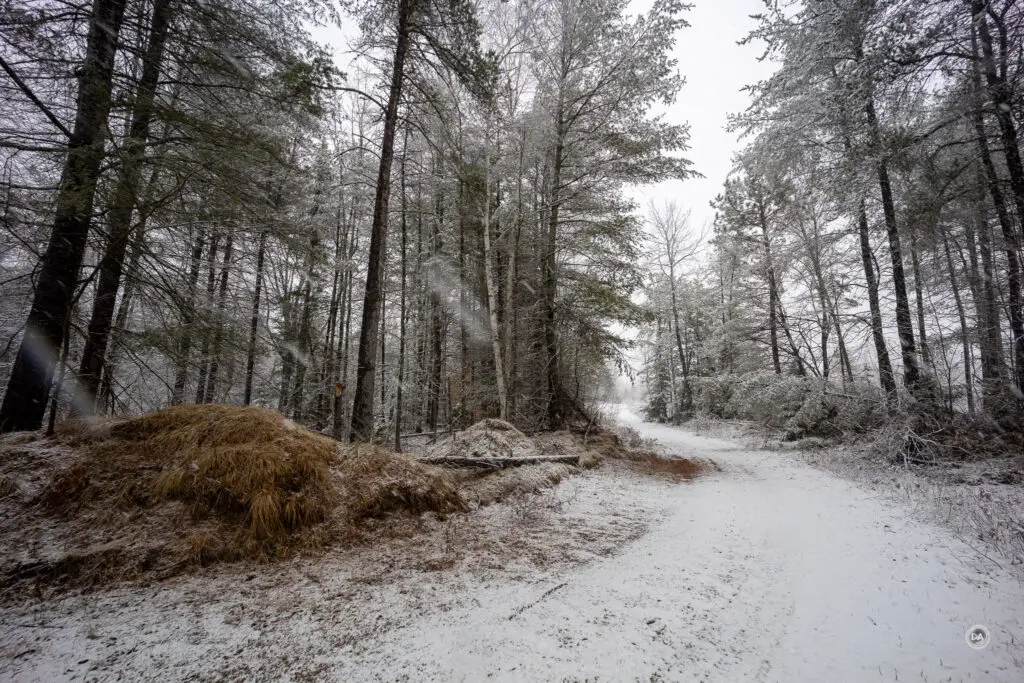
File options include RAW, CRAW, JPEG, and HEIF formats. Here’s a breakdown of the various aspect ratios and dimensions available along with the average file size for each.
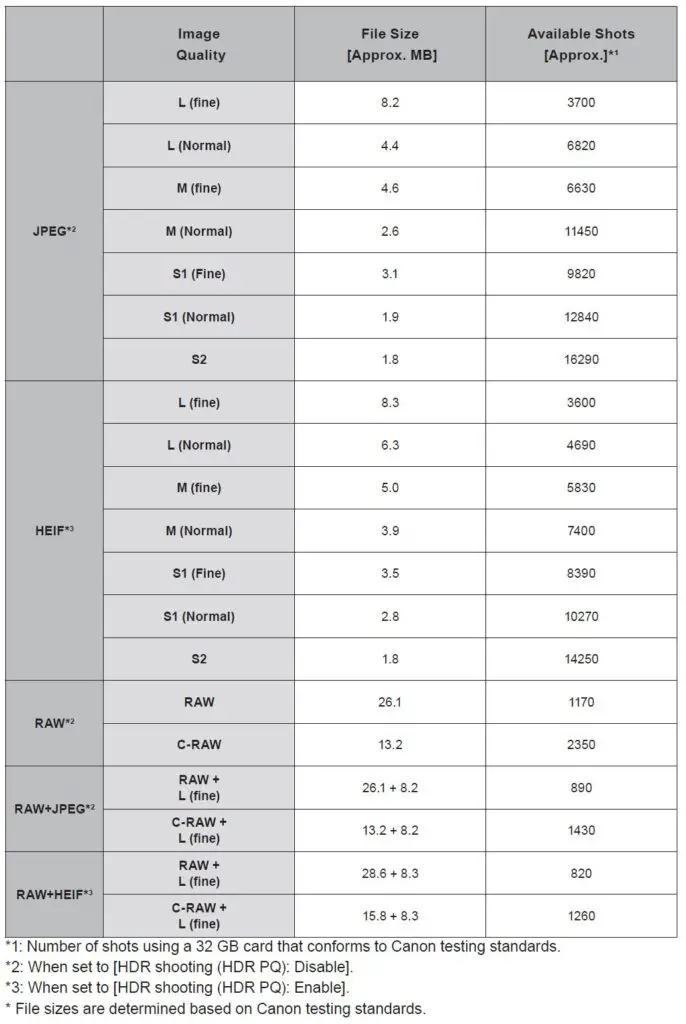
Canon used to offer Medium and Small RAW options but in more recent years has elected utilize their extremely efficient CRAW (Compressed RAW) option, which is a lossless compressed file that delivers both great efficiency in terms of file size but also very high quality. It is my go-to option in my cameras, as a lot of tests over the years have demonstrated that it is near impossible to spot any differences from the full size uncompressed RAW options. So, while offering near equal quality, CRAW delivers files that are only about 54% of the size of the uncompressed RAW options. At ISO 100, for example, an uncompressed RAW file will be around 26MB, while the CRAW file is a relatively diminutive 13.2MP. Canon .CR3 “wrapper” is extremely efficient as well, delivering smaller file sizes in general relative to competitor’s RAW files. The EOS R8’s images generally look great – good detail and color.

This sensor is kinder to lenses like the RF 24-50mm F4.5-6.3 kit lens than my EOS R5 (45MP), which tends to really reveal the flaws and shortcomings of “lesser” lenses. I found while I could tell that the detail and contrast wasn’t as good if I compared it side by side with, say, the RF 28mm F2.8 STM (a surprisingly strong little lens), I still found images acceptably good.
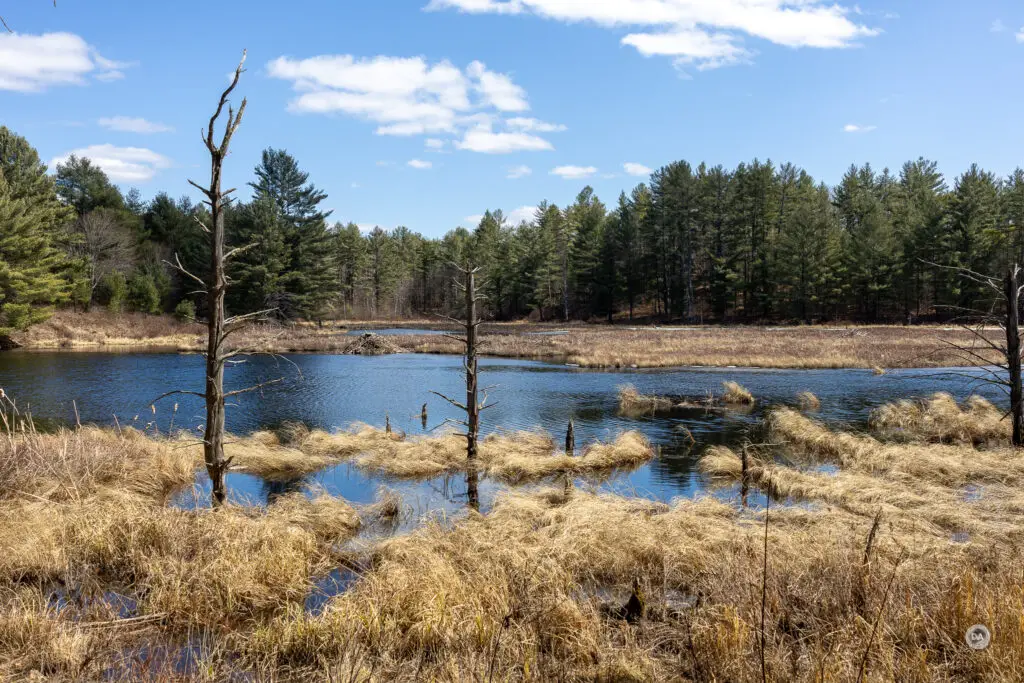
Typically high resolution sensors come with some baggage like increased noise at higher ISO levels, while a lower resolution sensor like this allows for more robust low light work. I’m used to working with higher resolution levels, so I do miss the extra pixels, but this is a sensor that will allow for good resolution, good dynamic range, and also a strong performance at higher ISO settings.
We’ll break those things down in a little more detail here.
Dynamic Range
I’ve taken to referring to the charts over at Photons to Photos as a quick reference to supplement my own tests. According to them, the dynamic range performance of the EOS R8 is essentially identical to that of the EOS R6 MKII (which stands to reason, as this is the same basic sensor). That is very competitive among Canon’s recent sensors, besting the original R6 and falling only slightly behind the R3 and R5 sensors. They rate the R8 at a maximum of 11.58 stops of dynamic range. The RP’s sensor? Only 9.1 stops – more than 2 1/2 stops less! The EOS R8 produces more dynamic range at basically every ISO setting, but particularly at lower ISO settings.
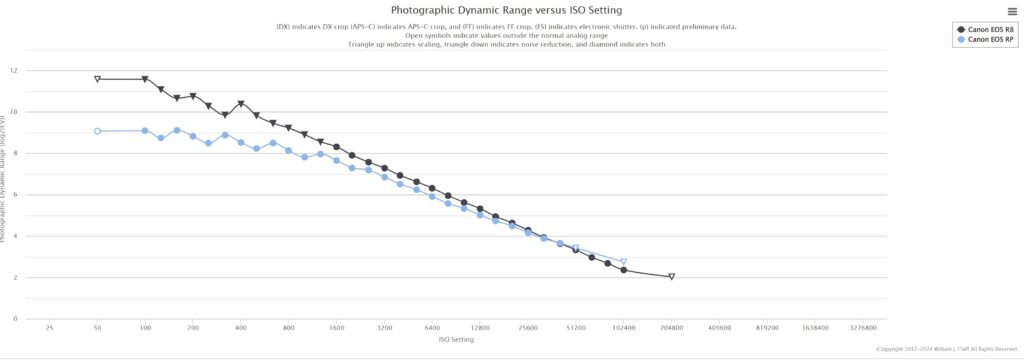
This is competitive with the sensor in the Sony a7C/2 and bests the one found in the Z5. Bottom line is that this new Canon sensor is, by the numbers, a very good sensor for dynamic range performance. We’ll see how that bears out in real world testing.
For my tests, I establish a base exposure (neutral or correct) and then subsequently under and overexpose the image by progressive stops. I typically go as high as 4 stops of overexposure and 5 stops of underexposure as modern cameras tend to be better at recovering shadows than they do highlights. I then add or remove the appropriate stops of light in post to see how the sensor does in recovering the lost information. Here’s a look at the properly exposed image for reference:
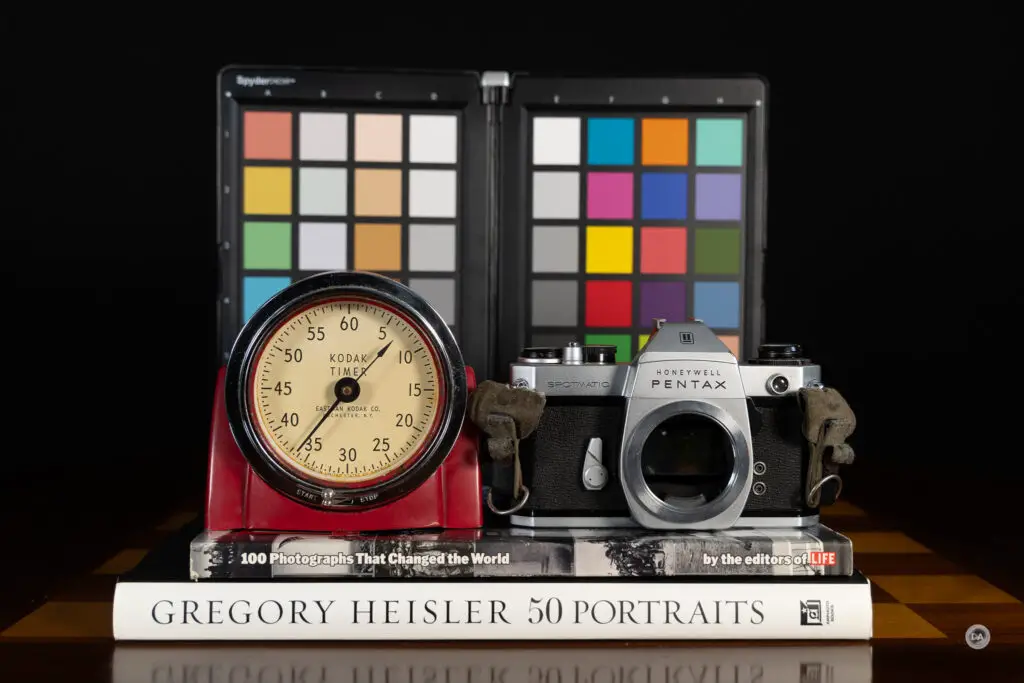
We will examine how the colors are retained, the purity of the shadows and highlights, and how noise impacts the image.
Modern cameras are typically very good at recovering shadows. At four stops of underexposure the unrecovered photo shows deeply crushed shadows and very little of the subject visible, but the shadows are easily and cleanly recovered by adding those four stops of light back into the photo. The end result is a photo that looks largely like the original (correct) exposure.
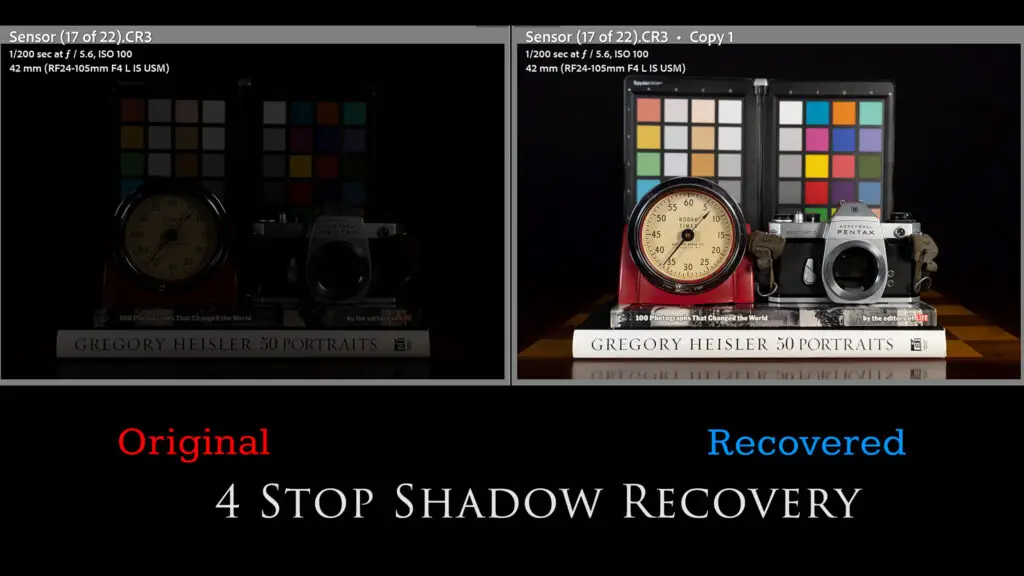
We find the limit between 4 and 5 stops, however, where I start to see the familiar signs of things falling apart. I don’t see a lot of additional noise, but I do see more evidence of “smoothing” by the sensor to try to defeat the noise. There’s a little less detail, and I also see color shift along with some blotchy color banding scattered throughout the image. You can see how clean the 4-stop recovery on the left is relative to the 5-stop recovery on the right.
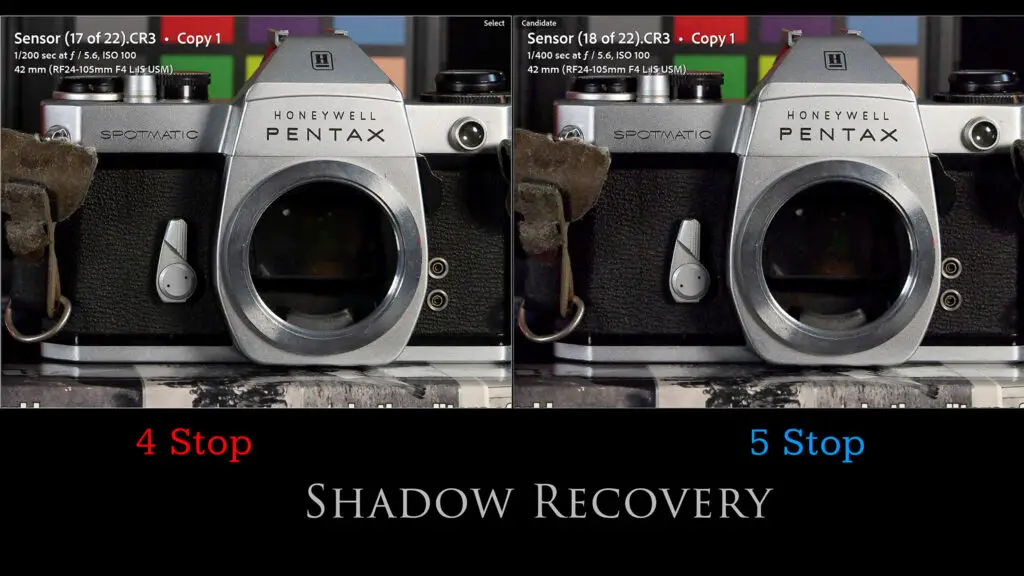
So, shadow recovery is good, but there is a limit to how far you can go without penalty.
How about highlights? We will now reverse the process. I’ve gradually overexposed a series of images, one stop at a time, and then attempted to recover the highlights in post. Typically you will start to see the image fall apart after a few stops in a couple of ways: 1) certain colors are lost and are not recoverable, and 2) information will be lost in blown highlights that isn’t recoverable.
At two stops the recovery (on the right) is near perfect. The color swatches all look correct and I don’t see lost information in the highlights. The color in the timer face on the left has been thoroughly recovered and looks even.
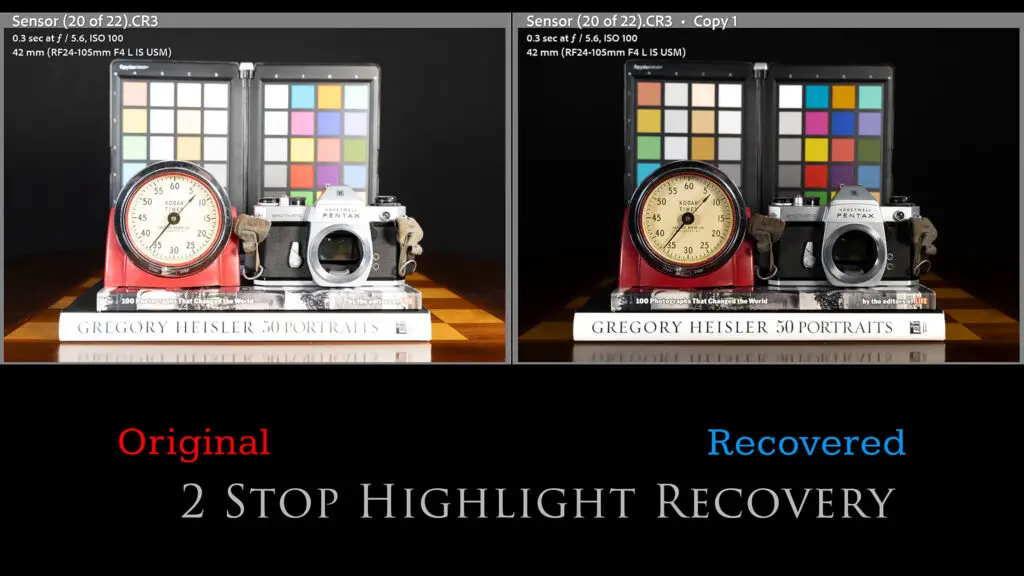
At three stops, however, the limits are slightly exceeded. You can see that in comparison to the 2 stop recovery (on the left) that the 3 stop recovery (on the right) on the right has missing color information on the timer face and some of the color swatches. The brightness on the spine of the Heisler book on the bottom hasn’t been regained, and that’s true of the Pentax camera as well.
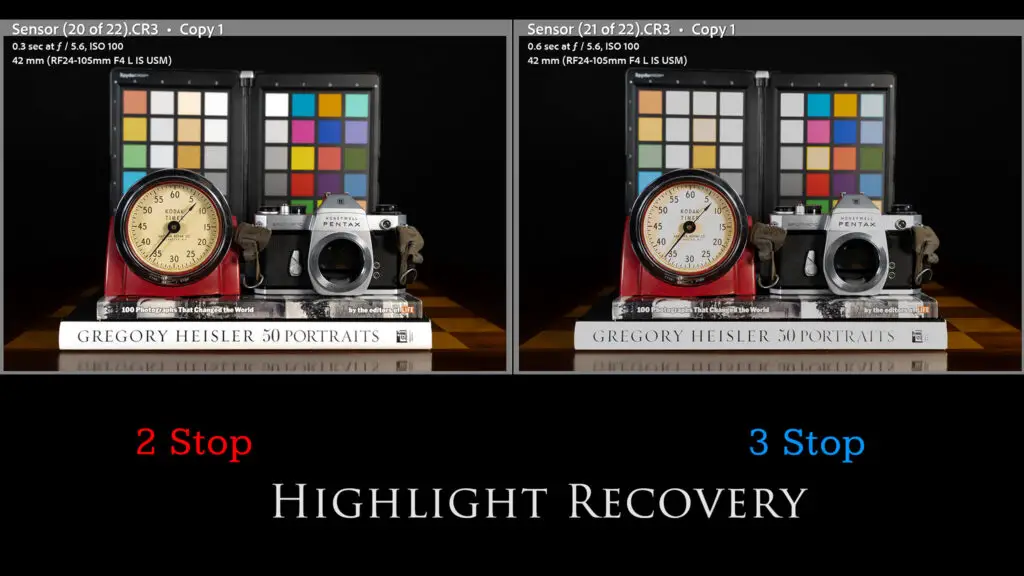
The image is useless at four stops of overexposure, so don’t attempt that. I found that there was sufficient real world dynamic range to allow me to recover both shadows and highlights enough to make real world results more pleasing. I’ve taken this broad dynamic range shot on the left and recovered information in both the shadows and highlights to make for a much nicer, brighter end result.

This is a competitive performance that I found entirely useful for real world use.
ISO Performance
In a perfect world we could all shoot in perfectly lit scenes, but reality dictates that sometimes we have to shoot in lower light situations. The EOS R8 has amazing low light autofocus (with sensitivity down to EV -6.5, though that requires having an F1.2 lens attached), but raising the ISO always comes with some penalty. Improving technologies help to mitigate some of that, and we will find out how much in our tests. We saw from the chart above that while the dynamic range at ISO 100 is about 11.5 stops, by ISO 25,600 that DR has dropped to just 4.3 stops. Raising the ISO also results in increased noise, potential color banding and color shift, and loss of contrast.
I compared each stop of ISO in the standard range to the base ISO of 100. Through ISO 3200 the results remain extremely clean, with an almost imperceptible amount of noise.
At ISO 6400 things look fine on a global level with no real apparent difference between base ISO and ISO 6400:

At a pixel level you can see how clean the image the still is, with a bit of noise in the color swatches and timer face, but good color consistency and contrast in the grip of the camera.
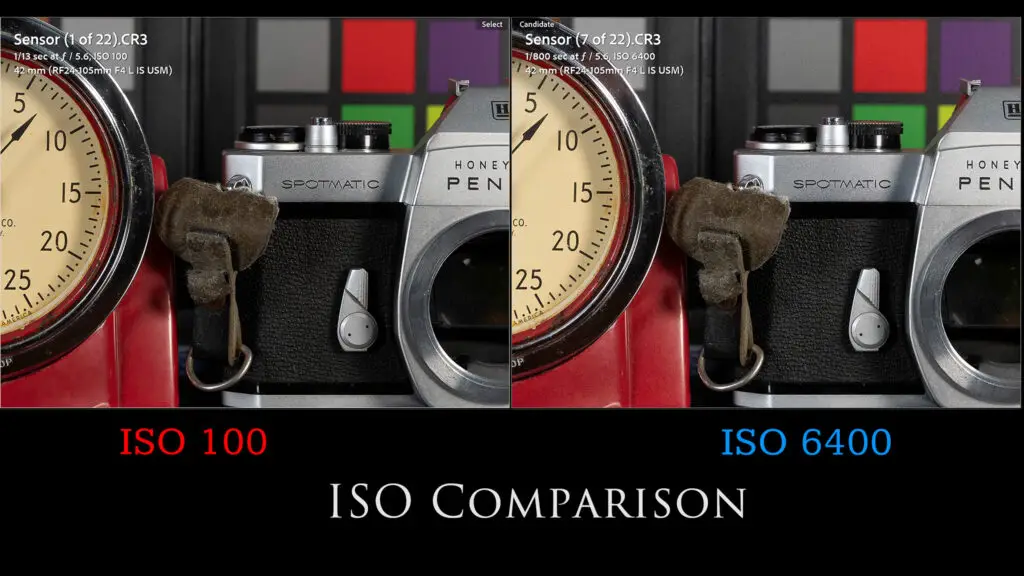
Through ISO 12,800 results continue to be very clean. There’s a bit more noise, but the pixels are still quite even in the black levels which allow contrast and color saturation to remain quite consistent:
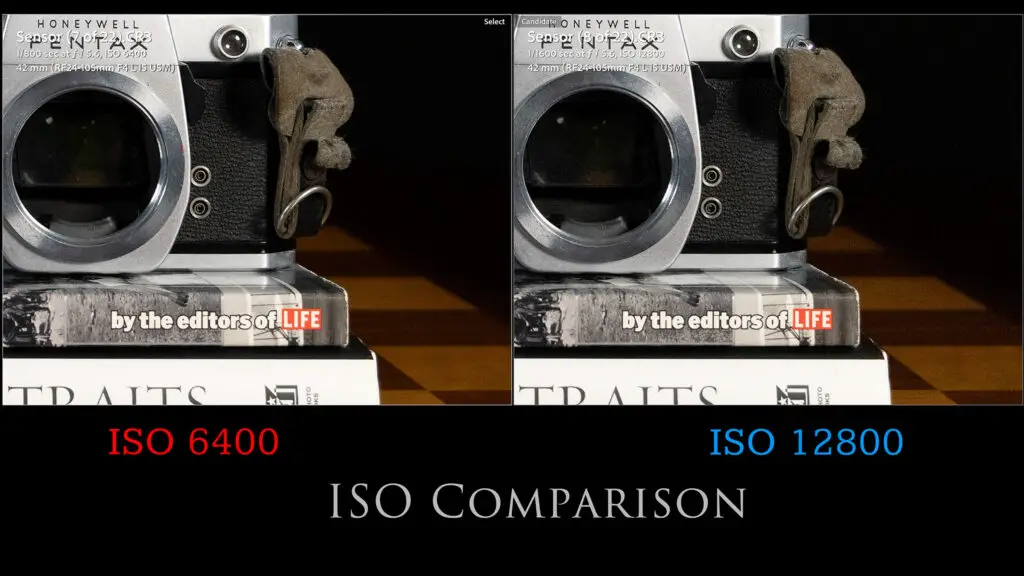
By ISO 25,600 the image is still usable in some situations. The image when viewed globally looks largely the same as at ISO 12,800, but when you look closer you can see slightly reduced black levels and contrast due to some “hot” pixel noise. The noise pattern is more obviously rough at a pixel level, though I would say the end result is still as good or better as some cameras at ISO 12,800, making this one of the better low light sensors.
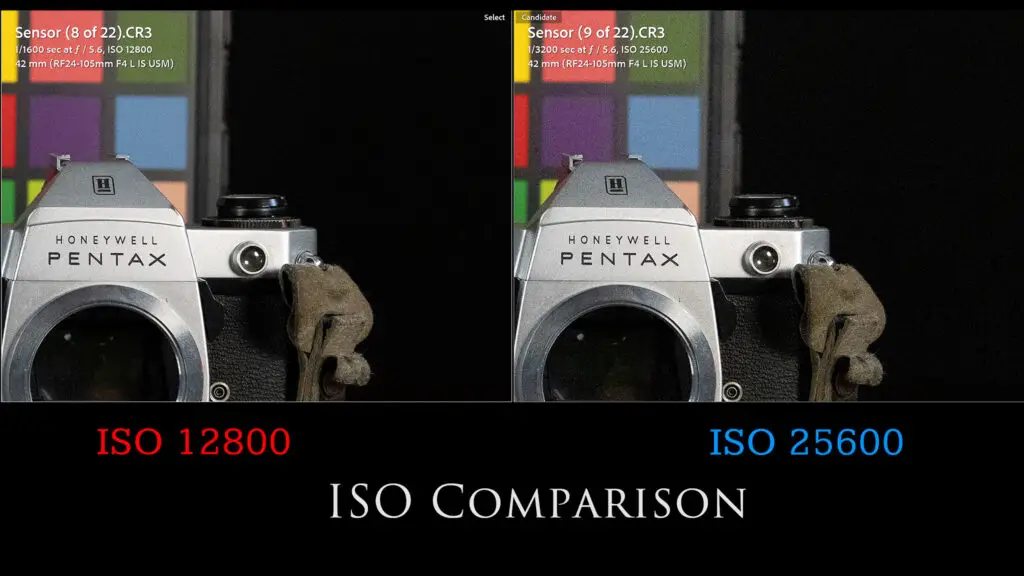
ISO 51,200 might be usable in a pinch, though with the cost of reduced contrast and more visible noise, but ISO 102,400 crosses the threshold into the unusable, with a bit of a green shift, some honeycombing in the shadows, and very rough noise levels.

Real world results at high ISO varied according to the backgrounds and textures, and I always prefer high ISO shots in monochrome, like this shot at ISO 51,200 of some knickknacks on a shelf.
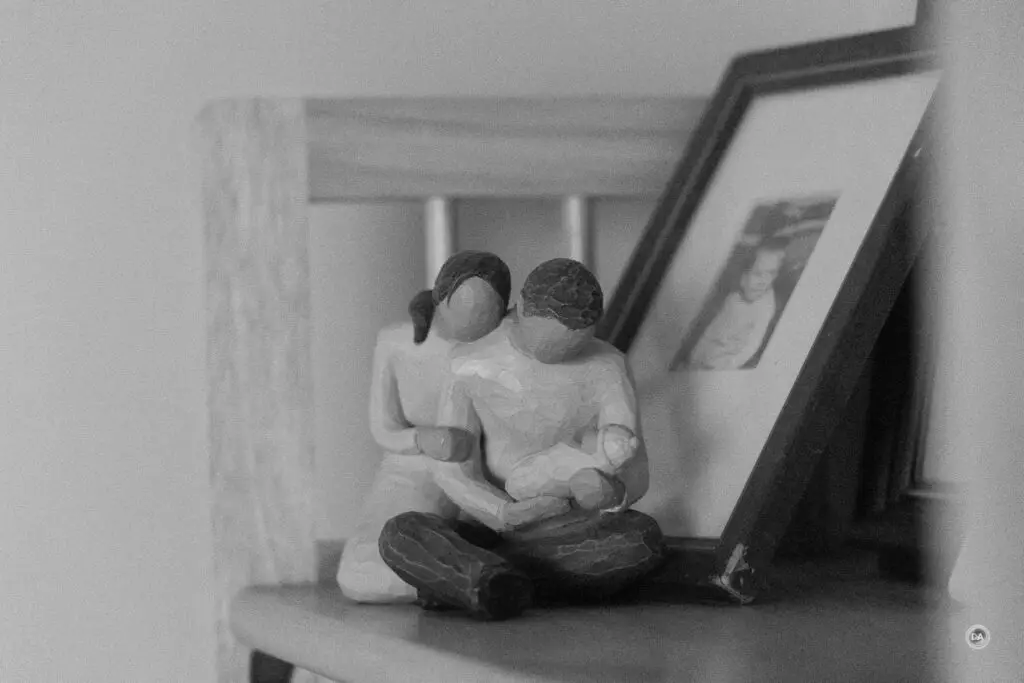
Another shot in a near dark bathroom shows some pattern in the areas that should be even along with a few color blotches, but it isn’t terrible, either.
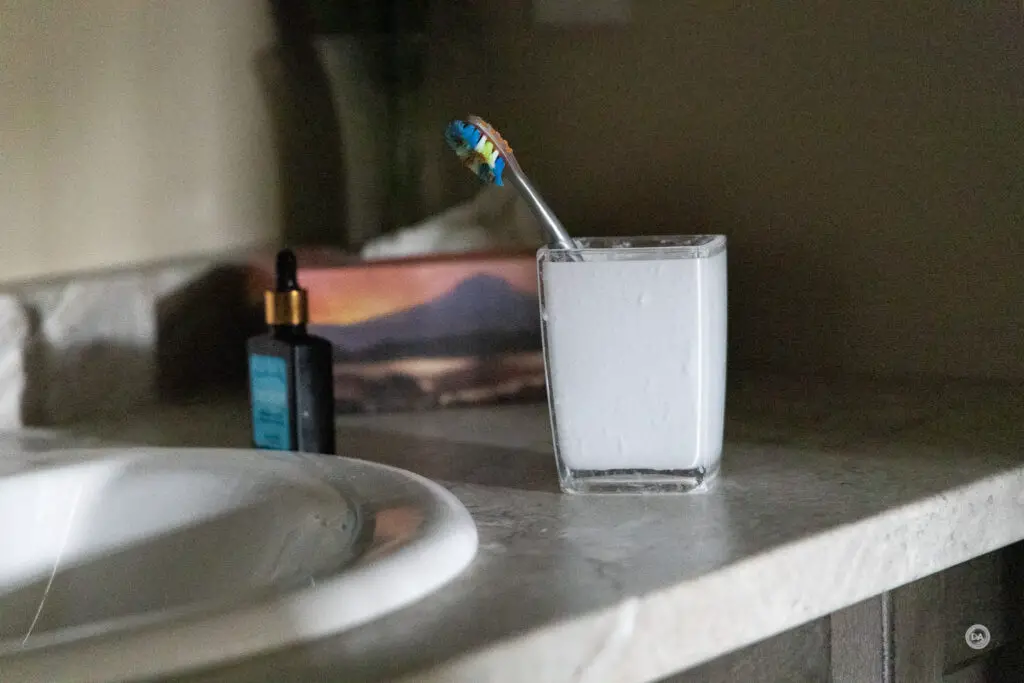
This is a camera where you could easily use the F4 zooms rather than the F2.8 zooms for event work as the low light performance is so solid. Shooting at ISOs like 3200 or 6400 is effortless. You could definitely get away with some of the “weird” RF lenses like the 600mm/800mm F11 primes or the RF 100-400mm (which is F8 on the telephoto end) because you can jack the ISO up with less consequence.
Image Quality Summary
While I am more accustomed to have more resolution on tap, I generally found the EOS R8’s sensor to be a joy to use. In some ways I’m reminded of my Sony a9 that I used for years, as it had a similar resolution and there was something about the images I took with it that I always liked. Canon’s color science remains excellent, and I was happy with the look and color of images in a wide variety of settings.
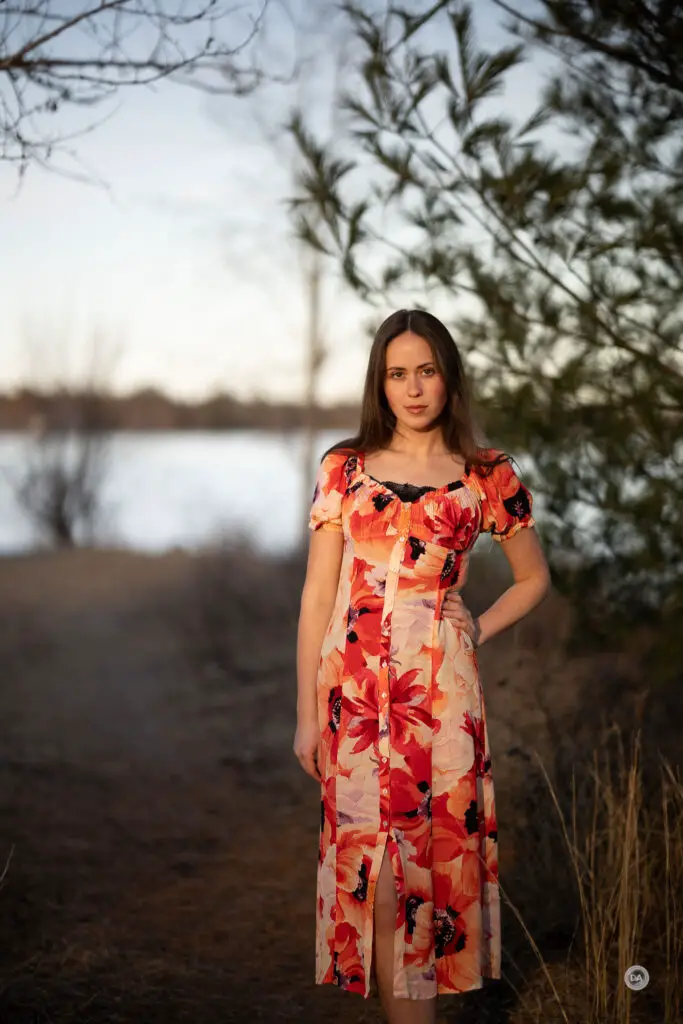
The dynamic range and high ISO performance is excellent, which allows you to focus on just taking images that make you happy…in all seasons!

If you own an EOS RP, it this sensor that will be one of the top reasons to upgrade.
Conclusion
At $1500 USD (currently $1300 USD) the EOS R8 is destined to be one of Canon’s best selling cameras. Most of the time the camera options near this price point have a smaller APS-C sensor, so this will almost certainly entice some people to take the plunge to the larger full frame sensor and the resulting image quality that comes with it.
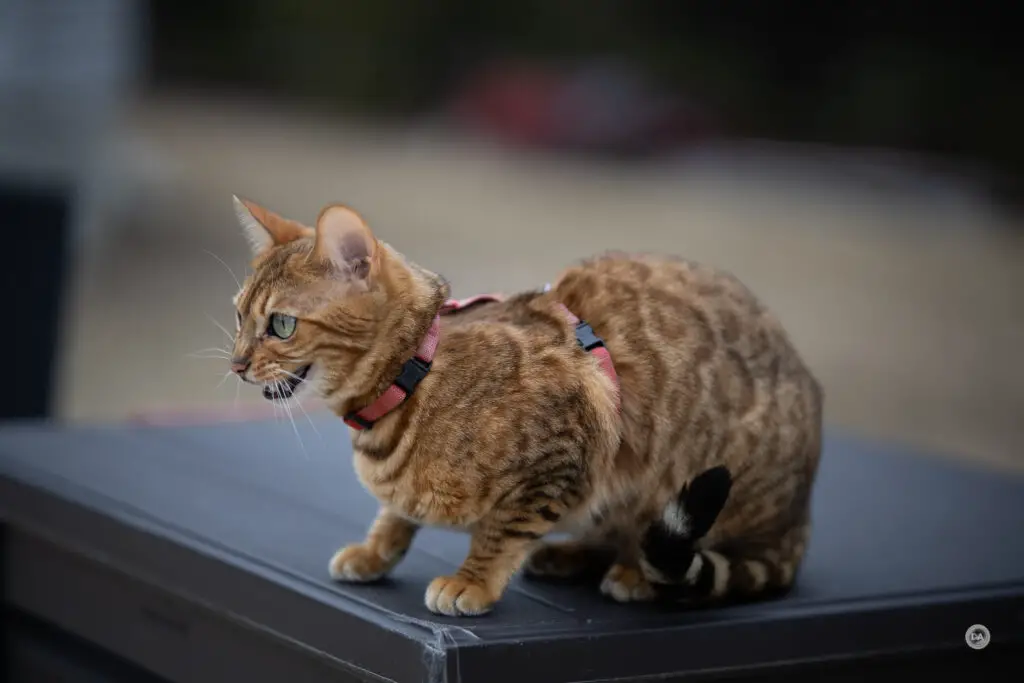
If you like the form factor of the EOS RP but are ready for an upgrade, the EOS R8 is a great option. It has a much better sensor, a much better focus system, and far better video specs (this was a real weakness in the EOS RP). There are still some limitations, but this camera does a lot of things really well and can make beautiful images…and be a lot of fun doing it.

My single greatest regret here is the lack of in-body-image-stabilization, as this has become a fairly ubiquitous feature on competing cameras and some of Canon’s best lens matches for this camera don’t have lens stabilization. But other than that I definitely prefer the Canon EOS R8’s ergonomics to, say, Sony’s a7C series of cameras, and the Canon costs less, too. But Canon also has a severe liability compared to the Sony options – there are only a fraction of the lens options available on Canon relative to what is available on Sony. I have a list of 25+ compact, relatively inexpensive lenses on Sony E-mount listed in my a7C series of reviews…and that’s only the primes that I could think of at the moment. I couldn’t put together a similar list with even seven options on Canon RF at the time of this review. That’s not a problem if you tend to get a few favorite lenses and use them exclusively, but if you like options, Canon’s “closed door” policies aren’t doing them any favors. It’s a shame, as the EOS R8 is a lot of fun.

Pros:
- Great blend of compactness and usability
- Great grip
- Responsive touchscreen with good resolution
- Up to 40FPS with electronic shutter
- Autofocus system is top notch
- Tracking is impressively good for a budget camera
- Love the “auto” mode for subject detection
- Great sensor
- Good dynamic range
- Excellent ISO performance
- Good color science
- Great price for a full frame camera
Cons:
- No IBIS
- Smaller battery
- Lens options limited by no third party lenses
_________________________________________________________________________
GEAR USED:
Purchase the Canon EOS R8 @ Camera Canada | B&H Photo | Adorama | Amazon | Amazon Canada | Amazon UK | Amazon Germany
___________________________________________________________________
Some Compact Lenses to Consider:
Purchase the Canon RF 28mm F2.8 @ Camera Canada | B&H Photo | Adorama | Amazon | Amazon Canada | Amazon UK | Amazon Germany
Purchase a Canon RF 16mm F2.8 STM @ B&H Photo | Amazon | Camera Canada | Amazon Canada | Amazon UK | Amazon Germany | eBay
Purchase the Canon RF 24mm F1.8 Macro IS @ B&H Photo | Amazon | Camera Canada | Amazon Canada | Amazon UK | Amazon Germany
Purchase the Canon RF 35mm F1.8 IS STM @ B&H | Amazon | Camera Canada Amazon Canada | Amazon UK | Amazon Germany | Ebay
Purchase a Canon RF 50mm F1.8 STM @ B&H Photo | Camera Canada | Amazon | Amazon Canada | Amazon UK | Amazon Germany | Ebay
Purchase a Canon RF 85mm F2 Macro IS STM @ B&H Photo | Camera Canada | Amazon | Amazon Canada | Amazon UK | Amazon Germany | Ebay
_________________________________________________________________
Want to support this channel? Use these affiliate links to shop at: B&H Photo | Amazon | Adorama | Camera Canada | Amazon Canada | Amazon UK | Ebay | Make a donation via Paypal
Buy DA Merchandise https://bit.ly/TWIMerch
Keywords: Canon EOS R8, EOS, R, R8, Review, Canon EOS R6 MK II, Canon EOS R6 II, EOS R6 II Review, RF, mirrorless, Canon EOS R7 Review, Sports, Tracking, Dustin Abbott, Real World, Comparison, Handling, Focus, Portraits, Resolution, High ISO, Image Quality, Sample Images, Photography, 45MP, 24MP, Canon, #letthelightin, #DA, #EOSR8
DISCLAIMER: This article and description contains affiliate links, which means that if you click on one of the product links, I’ll receive a small commission. As an Amazon Associate I earn from qualifying purchases.










 Nikkor Z 35mm F1.2 S Review
Nikkor Z 35mm F1.2 S Review  Kase AF 85mm F1.4 Review
Kase AF 85mm F1.4 Review  Fujifilm X-Half Review
Fujifilm X-Half Review  Nikkor Z 35mm F1.8 S Gallery
Nikkor Z 35mm F1.8 S Gallery 


